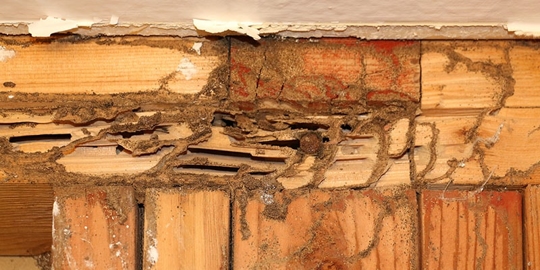Understanding the subtle, yet profound, differences between ants and termites could save you thousands of dollars. And a massive headache.
While both insects are similar in appearance, colony size, and social behavior, these rival pests can inflict a wide variety of destructive damage if left unchecked.
Eastern Subterranean Termites, the most prevalent termite variety in Georgia and South Carolina, can especially impose detrimental costs to your wallet and peace of mind.
Protecting your home against these unwelcomed guests can be an intimidating task, but you’re not alone! All homeowners living in the southeast experience ants and termites to some degree. Thankfully, there are calculated, preventative measures you can take to preserve the structural integrity of your biggest investment.
Let’s examine the primary differences between these two irritating invaders, analyze the gravity of their respective damage patterns, and weigh your options to ensure your home is armed with the most optimal defense.
Ants vs. termites
Termites and ants look very similar, so the untrained eye may not immediately distinguish the variance. The best clues are hidden in their physical appearances.
While ants boast a wide range of shapes and sizes, most have narrow thoraxes, round abdomens, and bent antennae. Most species of termites, on the other hand, are characteristically uniform, sporting rice-shaped bodies, thinner abdomens, and straight antennae.
Flying ants vs. flying termites (swarmers)
It may be simple to differentiate crawling ants from crawling termites, but distinguishing the insects’ aerial teammates is considerably more difficult.
While airborne, the two insects look identical. Only by taking a closer look can one find the peculiarity. Both areal insects bare four wings, but the termites’ wings are longer and symmetrical. Flying ants, however, have larger wings closer to the head, and a shorter pair in the hind.
Termites regularly shed their wings after swarming, which is a helpful indicator if these wood-eating pests are invading your home. Homeowners may discover tiny, pale, quarter-inch wings sprinkled in and around their property, a strong forewarning of an impending problem.
Habitat and social behavior of termites
Subterranean termites, as their name suggests, live below earth’s surface. After identifying a food supply above ground, termites navigate via shelter tubes, a moist burrow of soil that guides them through your entire home.
Thankfully, these shelter tubes can be easy to detect if looking in the right places. Some shelter tubes are hidden between wood beams and behind insulation, but many may be exposed in plain sight: along the base foundation of a house or dangling from a floor beam in a crawl space.
Analyzing the damage: termites or carpenter ants?
Carpenter ants, the most prominent wood-damaging ant, don’t consume wood for food. Instead, they dig galleries for nest building and passage. If you spot sawdust-like material near a damage area, that is a good indicator that you’re dealing with carpenter ant–not termite–activity.
Signs of termite damage present a slew of hazardous problems, most notably to the structural integrity of your home. Termites can, if untreated, totally decimate the wood, threaten unrecoverable destruction, and at worst, collapse your home.
Fun Fact: Termites inflict, on average, close to $5 billion in damages nationwide, which is more than fires, earthquakes, and natural disasters combined. Homeowners’ insurance doesn’t cover termite damage because of this staggering number.
What should you do next?
Are you worried about these unwelcomed invaders pillaging your home and compromising your most valued asset? Let Compass Pest Management’s termite control specialists help you reclaim your peace of mind from these tiny, but titanic, pests.
Our team of experienced technicians can detect early infestations, prevent structural damage, and implement state-of-the-art treatments to ensure your home is properly guarded by the most superior protection on the market.
By scheduling a free inspection and estimate with Compass Pest Management, you can:
- Prevent thousands of dollars in structural damages
- Analyze pre-existing damage threats
- Detect early infestations
- Enjoy peace of mind
Take the next step to make your residence a pest-free home. Contact Compass Pest Management today.
The post Distinguishing Ants from Termites: A Tale of Two Ferocious Adversaries appeared first on Compass Pest Management.

